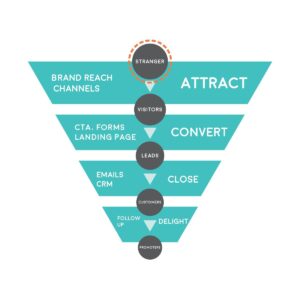What is Marketing Automation? How to implement Marketing Automation in an Inbound direction? In this article, let’s dissect each layer of this term and find the most suitable Marketing Automation strategy for your business.
What is Marketing Automation?
“In the marketplace, whoever is faster is the winner.” This statement is becoming more evident than ever in the strong digital transformation needs of businesses, where the trend of Marketing Automation is gradually being emphasized as one of the indispensable aids for employees.
Marketing Automation is the application of technology platforms to automate marketing activities. Many businesses have applied Marketing Automation to repetitive tasks such as Email Marketing, posting on social media platforms, and even running and tracking advertising campaigns.
They not only bring efficiency after business campaigns but also optimize the customer experience, making communication more personalized and, notably, saving significant time and effort for employees. As a result, it helps them focus on other tasks that bring higher value to the business.

Marketing Automation technology is making marketing in the modern era easier than ever before!
Benefits and challenges of using Marketing Automation
Benefits of Marketing Automation in the Inbound Marketing strategy
It can be said that Marketing Automation is the combination of strategy and technology, allowing you to reach and nurture target customers in the most natural way possible, thereby providing useful information to increase the likelihood of converting them into leads and achieving customer satisfaction goals.
To illustrate, think of Marketing Automation as a growing garden. What do you need to care for the garden? You will need fertile soil for growth. You need seeds to sow, water to irrigate the garden every day to keep it fresh.

With a good Marketing Automation campaign, you can easily nurture leads (seeds) to become loyal customers (mature trees).
However, customers are not just the output of a successful marketing automation process. Like the Growth Flywheel model, they should be at the center of all your marketing activities. This means that Automation tools should be bridges to connect customers with the brand.
That’s why you shouldn’t place customers at the end of the funnel model. Instead, customers should be at the center of the flywheel, providing additional momentum for the flywheel to spin quickly and continuously.
A successful Marketing Automation campaign will help you increase growth in line with the business’s growth momentum, support strengthening relationships with customers, even after they have completed the purchase process.
Challenges in using Marketing Automation
Although Marketing Automation is widespread, there are still misconceptions that it can be a “lifesaver” to solve any obstacles slowing down business growth, including the need to find new leads or convert them into customers. However, only Marketing Automation cannot suddenly generate more leads, more customers, and effective marketing but also needs to be applied in appropriate strategies, such as Inbound Marketing.
This misconception has led many marketers to use sophisticated automated tools to filter customers but forget that they need to attract new leads to apply those technologies. And it leads to not-so-good consequences!
Consequences of misapplying Marketing Automation
The consequence of this issue is that marketers have to purchase customer data from other sources instead of organically finding target customers in an Inbound direction. As you may know, purchasing data from other Data providers often results in data lists that are not the targeted people in your potential customer base (Buyer’s Persona).
Therefore, this may be a short-term method but not a long-term solution for sustainable business growth. And it also does not bring benefits to nurture relationships with your customers.
Many marketers also think about Marketing Automation in the funnel operating model instead of the Growth Flywheel model. Specifically, after receiving some leads, they put customer information into an email list and distribute it to salespeople.

Indeed, this will create a rather unpleasant shopping experience for customers every time they have to transition between Marketing, Sales, and Customer Service teams. Instead of establishing a sales process, a personalized, efficient experience for each individual customer’s needs, Marketing Automation becomes a tool that forces them to experience through channels with whimsical approaches and irrelevant content.
When applying Marketing automatically in this way, not only does it not bring efficiency, but it also increases conflicts, causing business activities to stagnate and making it difficult to maintain the brand’s relationship with customers.
How to deploy Marketing Automation in an Inbound direction
When is the right time to invest in Marketing Automation?
As mentioned, Marketing Automation is a trend in itself, so integrating automated marketing technologies into your business operations should be done as soon and as well as possible.
However, investing in Marketing Automation also requires sufficient conditions to successfully apply the technology. Be prepared to expand your working scale, make more efforts, and embrace more opportunities.
Investing in Marketing Automation will support nurturing quality leads and turning them into customers. Answering a few questions can help you evaluate whether Marketing Automation is the right step for you:
- Do you have a stable lead conversion flow?
- Do your Marketing and Sales teams agree on how to interact with customers at each stage?
- Is your Content plan suitable for your customer personas?
- Have you tracked customer behavior and interacted with them across all your sales channels, not just via Email?
- Have you established a customer nurturing strategy and expanded its scale?
These are good signs that Marketing Automation can help your business grow. The key is to understand that automation doesn’t help you do marketing but only supports the implementation of the plans you’re incubating.
Do’s and don’ts when applying Marketing Automation
Surely you understand the basics of Marketing Automation, so below, we’ll provide you with some tips to help you deploy your automated marketing campaigns better. The list is divided into “Do’s” and “Don’ts.” Let’s follow along!
Avoid merely applying technology without redefining business objectives
Because Marketing Automation makes marketing activities easier for marketers, typically, when we talk about applying technology to business operations, the first thing we do is to automate everything. Of course, this is the right step, but try to look back at your ultimate goal.
The issue here is that we don’t want Marketing Automation to lead us to inappropriate marketing practices. We also don’t want it to lead us to bad habits and stop listening and understanding customers.
So looking back at your ultimate goal will help you apply Marketing Automation in the right place and optimize your marketing strategy to a new level.
Apply Marketing Automation alongside your Inbound Marketing strategy
Being Inbound means providing valuable content relevant to customers’ interests and needs. When applying automated technology, you shouldn’t stop creating such quality content.
In fact, you need to upgrade your ability to access customer information by delivering content to “the right place they come to and at the right time they need it.”
Avoid conveying generic messages
With Marketing Automation, you often send generic messages or information to your entire customer list. And eventually, it ends up in the Spam folder because it doesn’t attract or benefit the reader.
Send highly personalized messages to your target audience
Provide information that people are looking for. Put yourself in the shoes of a customer. Imagine you’ve just encountered a brand, and you really like the marketing content the brand provides.
Imagine that the next Email you receive has nothing to do with what you just read. Do you feel uncomfortable? Wouldn’t sending an Email diving deeper into the information, knowledge you’re interested in about Marketing Automation be more impactful? Wouldn’t you want to buy products/services from that company more?
Marketing can help you realize all of the above.
Don’t forget your customers
Selling and closing deals is not a simple task; many companies focus on finding new customers and forget about their current customers. Remember that people who have bought products from you and liked them will often want to buy more.
Applying Marketing Automation can also be used to nurture existing customers, support Up-selling/Cross-selling to old customer files more effectively.
Build campaigns to attract existing customers back and make more purchases
Selling to people who have bought from you before is always easier than selling to new customers. Keeping customers continuously engaged with marketing content is a critical part of business growth. Don’t forget to nurture close relationships with customers by sending them messages specifically tailored to them to make them feel cared for. From there, they’ll want to keep coming back to your brand.
Conclusion
Among the “myriads” of solutions available, what is the most suitable answer for your business?
HubSpot is the world’s leading All-in-one Marketing platform, providing integrated toolkits to manage and deploy your Marketing strategy by combining Inbound Marketing theory with practical Marketing Automation tools.
In Vietnam, GAPIT Communications is a Gold Partner certified by HubSpot for its ability to provide HubSpot software and related Inbound Marketing services.
If you want to improve the effectiveness of your business’s Marketing activities through Automation technology, bringing sustainable growth to your business, contact Digital Mind now for more detailed advice on sustainable growth methods in an Inbound direction!







